
Did you know that 70 percent of customers would rather use a company’s website to find information instead of phone or email?
When we search on the internet, we’re looking for answers as fast as we can get them, and we tend to trust those who can deliver answers reliably. To create the least amount of friction for customers, companies create knowledge bases for their online audience.
If you want to develop more trust between you, your employees, and your clients, building a knowledge base is crucial.
By creating a knowledge base that effectively informs both customers and employees about your business, you’re enhancing your company’s customer service, securing more trust from potential customers, and providing an overall better experience for customers and employees alike.
Let’s dive in so you can learn how to make a knowledge base and effectively take advantage of them.
What is a Knowledge Base?
Knowledge bases are online libraries for customers and employees that are full of information regarding a specific product, service, or company.
You probably used a popular knowledge base to land on this article.
I’m talking about Google – which seems to have established itself as the internet’s all-encompassing knowledge base. You can find information on just about anything with Google, and it creates the optimal user experience for its millions of daily searchers.
It’s important that knowledge bases are both:
- Machine-readable, meaning that computers are able to access and utilize this data to provide answers for the requestor.
- Human-readable, meaning that humans can read the information clearly and directly.
While brainstorming knowledge base ideas, it’s crucial to keep the customer in mind: what information would they be looking for? What problems do you anticipate customers having?
The answers you think of should be the content that makes up a knowledge base.
Why Do You Need a Knowledge Base?
Just because Google dominates the search game doesn’t mean your company shouldn’t have a knowledge base of its own. Here are some key reasons why they are so effective.
Helpful for Reps
For one, knowledge bases are helpful for anyone who represents the company. They can tap into the company’s knowledge base to ensure that they are up to date with the latest information on the company.
Includes Plenty of Content
Knowledge bases give you an opportunity to enhance your online presence with robust stores of content for anyone to benefit from.
Not only will quality content improve your chance of ranking on Google, but you’ll establish more trust online, which can lead to more customers and higher revenue.
Immediate Accessibility For Customers
According to data from HubSpot Research, 90% of consumers consider an “immediate” response as important or very important when they have a customer service question.
Simply put, speed matters.
To meet consumer expectations, it’s essential for companies to build out their knowledge bases so that every question gets answered. It’s not just important for customer creation but also for customer retention. If customers can’t find information about your company quickly and easily, they’ll look elsewhere.
To that end, make sure your knowledge base is easily accessible and properly answers customer questions. If your content can’t seem to solve a customer’s specific problem, be active and speak directly with them to make sure they’re helped in another way, whether through email, live chat, or a phone call.
Easy to Build
It doesn’t take a senior web developer to build out a robust knowledge base. If you know the ins and outs of your company, all it takes is a little technical practice to make that knowledge accessible to your customers.
Considering the benefit it can bring to your employees, customers, and business, it’s worth the effort to put it together.
I’ve broken the process down into these ten simple steps so you can create your own knowledge base.
Creating a Knowledge Base
Keep in mind that for knowledge bases to be effective, you don’t need a deep understanding of web skills, but you will want to have a deep understanding of who your customers are, what specific problem you solve for them, and how your customers would want to have information delivered to them.
1. Begin with the Design
Translating your company information to the consumer all begins with design.
ChatGPT became the fastest technology in the world to hit 1 million users. It took just five days.
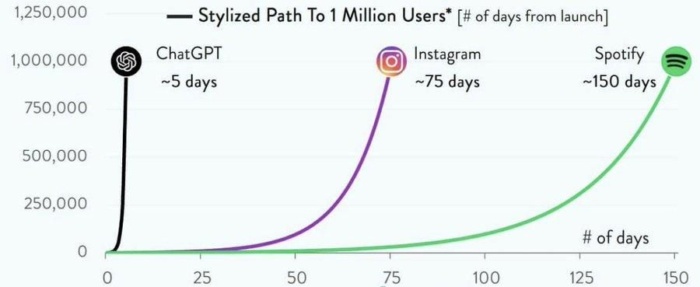
Source: Contrary Capital
From a design perspective, there’s one major takeaway we can gather from ChatGPT:
No matter how sophisticated the technology of a given product may be, if users can’t easily navigate it, they won’t bother with it.
ChatGPT has grown so quickly because of how easy it is to use. Not only does it provide answers to users’ problems, but it works as easy as a Google search.
In the land of knowledge bases, what does great design look like? It comes back to friction, specifically the lack of it.
The less friction there is in a product’s design, the easier users can take advantage of it. Think of what your customer is looking for and go with a design that complements their needs.
2. Choose Your Topics
It can be tricky to know what topics will be best for your customers. You can’t just guess what your customers’ needs are, but there are things you can do to uncover actionable data about what they could be.
The first and most obvious place to look through your previous customer support requests. Are there common issues or questions that customers consistently ask about? What about reviews – is there information you could share that would alleviate any issues raised there?
Beyond your own website, look externally to other websites like Reddit or Quora, where users ask all kinds of questions about a given company, product, or service. Searchers on these websites want to hear answers from other human beings rather than Google’s search algorithms.
Getting a more human perspective from these interactions can give you great ideas for specific content on your knowledge base.
3. Establish Content Creation
Now that you understand your topics and how to present information, it’s time to create.
This is where you begin building out the content, ensuring that the content is easy to navigate and helps the reader understand your company and the problems you solve.
To make great content, you need a cohesive content strategy. You’ll want to define your goals to know:
- when you plan on launching the knowledge base
- how to divide up content to reach that deadline
- whether or not to run promotions for the knowledge base when it goes live
You’ll also need a good understanding of your business to produce the right content. Are you a software company? Be sure to include plenty of tutorials. A local bakery? Cover any and all questions about the baking process, ingredient sourcing, and other relevant safety information.
You get the idea.
Finally, when the knowledge base does go live, have a plan ready to keep the knowledge base updated with new information on a regular basis to react to changes in the company, seasonal developments, or other unforeseen circumstances.
4. Include Visuals
Incorporating visuals into your content makes it more engaging, effective, and memorable for your audience.
Did you know 90 percent of the information we process is visual, and we retain 65 percent of information paired with visual content as compared to just 10 percent without any visual aid?

Not only do visuals leave more of an impression and make content more engaging, they also:
- break up long blocks of text, making your content more visually appealing and easier to read.
- illustrate complex concepts or ideas in a way that is easy for your audience to understand.
- increase the shareability of your content. Posts with images tend to get shared more frequently on social media, which can help to increase your reach and drive traffic to your website.
So, if you want to maximize the impact of your knowledge base, you need relevant and compelling images to complement your content.
5. Keep Your Knowledge Base on Brand
Your knowledge base should carry all the same brand elements that your customers are accustomed to.
This requires intention behind your website architecture. The structure of the knowledge base needs to complement the information in it. This means making sure the visual interface is consistent with other parts of your site and aligning your copy on the knowledge base with the rest of your site copy as well as brand tone overall.
UX design, tone of voice, grammar, and visuals should all reflect your brand and feel intuitive to the customer. If you have a deep understanding of who your target audience is, this part of the process will come easier.
6. Follow Accessibility Standards
The knowledge base on many sites is the equivalent of a car manual for your company and products, so it’s important to make it as accessible as possible keeping with proper ADA standards. A few key areas where you can start to contribute to accessibility include:
- Ensuring certain page elements (search bar, etc.) are in the same place consistently across all pages.
- Having alt text for all images.
- Making sure pages can be fully navigable by those limited to a keyboard.
7. Add or Update Your Knowledge Base Regularly
As with any other content on your website, you need to keep knowledge base content up to date and relevant to changes in the industry. Outdated content can hinder your online authority and drive away potential customers.
If you want to avoid becoming outdated, you need to commit to producing quality and current content for your knowledge, not just quantity.
8. Link to Your Knowledge Base
Part of understanding your customers is understanding where they may run into challenges.
Anticipating these roadblocks and including an internal link to a relevant article from your company’s knowledge base makes a big difference in building trust between you and your audience.
You want internal links to your knowledge base spread far and wide. Wherever readers may want to learn more, there needs to be a link to take them there.
For example, if I’m browsing an NP blog about conducting SEO research on Ubersuggest, I’ll include internal links to Ubersuggest’s knowledge base articles, like creating keyword lists with Ubersuggest, for example, and other relevant articles where necessary.
9. Measure Effectiveness
Here are some of the metrics you should keep track of to measure the effectiveness of your knowledge base:
- Page visits – This knowledge base metric gives you valuable insight into how easily customers find your knowledge base, if the content within it is helpful to readers, and which pages readers tend to be visiting the most.
- Top visited articles – This metric tells you what information within the knowledge base customers find most useful. Once uncovered, the popular topics that people tend to search for may spark new inspiration for content ideas that are relevant to your customers’ needs.
- Conversations resolved on first contact – The idea here is: if the reader could have found the information on their own, they wouldn’t have reached out for support. This helps you figure out how you can further focus your efforts on helping customers so that they don’t need to reach out to customer support. Narrow down where people are having trouble finding things and make adjustments so that content is as accessible as possible.
- Failed searches in site search – Generally, your site search is going to be the first place people turn to find info if you don’t have a knowledge base. Seeing what people have been looking for but not being able to find gives you insight into what other kinds of information customers think is relevant to your company, thus giving you more ideas for content. Perhaps you have information in your knowledge base that would have answered their question, but the wording of your content was different than the keywords the searcher used to find content. This may tell you what wording is best to use to enhance the SEO value of your content.
- Survey responses – With most knowledge bases, people tend to include a small popup next to the content asking readers how helpful the content was. Keeping track of this feedback from readers will give you a good idea of how effective (or not) the particular content is.
- Average age of content – Lastly, you need to be highly aware of how recent your content is. The older content gets, the less likely it is that others will continue referring to it. Internal content, as well as external links, should get an update regularly to make sure that newcomers to the knowledge base are always receiving the latest information.
10. Utilize Tools to Help
Knowledge base software helps you create, organize, and manage the content within it. This is critical to acting on the previous points made above. You need effective tools to be able fine tune things and ensure the best experience possible.
Here are a few software programs I like for managing knowledge bases:
- LiveAgent optimizes your ability to handle multichannel support, filtering all communication through one easy-to-use dashboard. It comes with knowledge base support software that makes it easy to build customer support into your knowledge base.
- Document360 comes with a ton of collaboration features that make it excellent for internal use. It lets you create two levels of access for internal and external knowledge bases, and you can create multiple knowledge bases for multiple projects.
- Zendesk helps you build feature-rich knowledge bases that can handle customer support systems too, all from one platform.
- Helpjuice provides great knowledge base solutions that come with detailed analytics for you to pull insights from.
- ProProfs is a free knowledge base software that lends itself to beginners. Despite it being free, it still comes with some great features and integrations that make knowledge base building a breeze.
Good knowledge base software will not only let you build a helpful resource for your customers, but also for your employees. The knowledge base can contain internal resources, like onboarding practices and training materials, to make sure that each employee has access to the information they need to excel at their role.
Effective Knowledge Base Examples
I’ve compiled a list here of 10 great knowledge bases online you can take a look at to gather inspiration for your own.
First, let’s take a look at Nike.
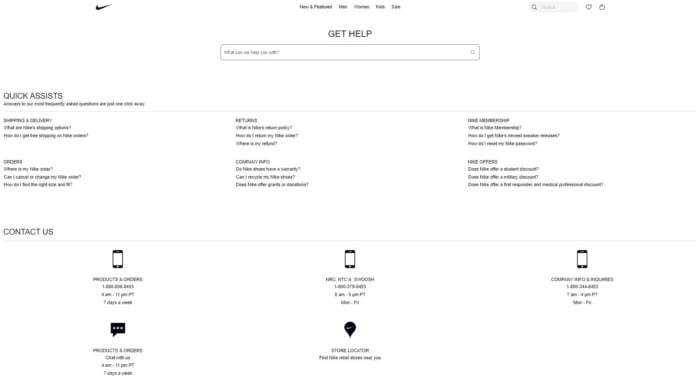
Notice the primary components here that make up this knowledge base: a search bar to prompt your own questions, organized direct links to the most common questions that Nike receives, and a contact section that offers multiple means of communication.
Nike demonstrates a knowledge base that’s both broad in coverage and specific in detail. Its design makes it very easy for users to navigate and includes information pertaining to just about any question that customers may have.
Instagram is another great example of how to design a knowledge base.
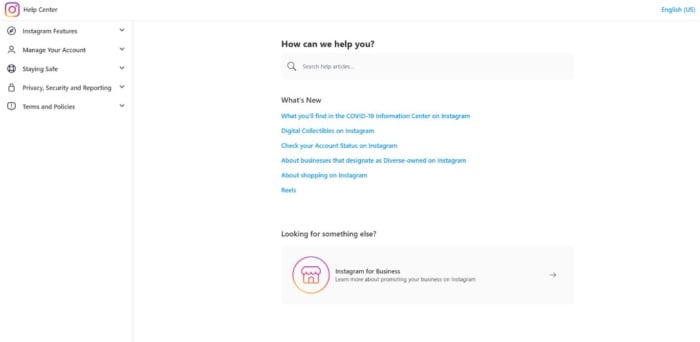
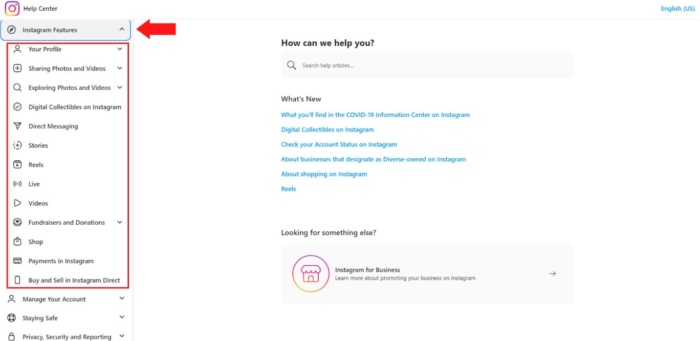
Instagram keeps things simple and supportive by incorporating dropdowns with categorized information.
Each dropdown carries a huge variety of information, so Instagram places a search bar in the center of the page to make it easy to filter through everything.
Finally, take a look at Spotify’s knowledge base.
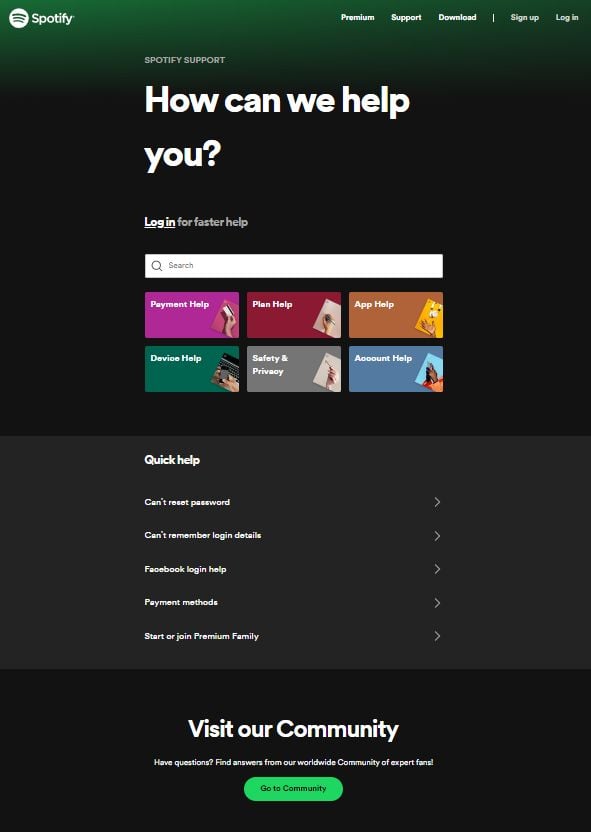
Not only does Spotify make its knowledge base incredibly easy to navigate, but its Quick help section is extra handy for quickly moving customers to a solution. Quick help covers some of the most common problems people tend to have on the streaming platform, and removes that extra bit of friction for customers by avoiding the search bar altogether.
It’s the small details like these that make for a great knowledge base user experience.
FAQs
Keep these three things in mind when structuring a knowledge base:
Sort content into helpful categories based on what your audience needs
Create a user experience that’s effortless to navigate
Provide extra communication channels like phone numbers or an email to offer additional help
When thinking about what type of data is provided in a knowledge base, think about what the user would be looking for. What type of business are you, and what problems tend to arise with that type of business?
For example, a product knowledge base for a retail or E-commerce company focuses much more heavily on shipping-related information, whereas a social media platform should have plenty of in-depth tutorials to learn how to use the platform.
If you look at Nike’s knowledge base, you’ll notice a neatly categorized “Quick assists” that answers common questions, and a clear search bar to filter through information. Along with multiple channels for communication, Nike makes it as easy as possible for users to find answers.
Another example is Instagram, which neatly categorizes its information into folders that make for an intuitive user experience.
An FAQ page has answers for specifically targeted questions, while a knowledge base is more of an all-encompassing, general knowledge resource. In many cases, it pays to have both of these on your site. FAQs are great for people who may have a quick, specific question they need answers for. A knowledge base is better for those that want to do a deep dive to learn about a product or service.
Conclusion
Creating a knowledge base doesn’t have to be some huge undertaking. With what we’ve discussed in this blog, you should be well-equipped to create your own and develop a more robust customer support system for your business.
Not only does a knowledge base make your business more appealing to curious customers, but it makes your website more appealing to Google as well.
So, not only will you be making your website better for customers and employees, but Google’s search algorithm will have a lot more to work with to move you up in the search rankings.
Be sure to check out the Ubersuggest knowledge base for more inspiration, and check out my consulting services if you’re looking for additional help.
Make your online presence an open book for questions, as if you were sitting in the room with them. If your customers feel heard, they’re more likely to be coming back for future business.
What other ways are you helping customers online?

See How My Agency Can Drive More Traffic to Your Website
- SEO - unlock more SEO traffic. See real results.
- Content Marketing - our team creates epic content that will get shared, get links, and attract traffic.
- Paid Media - effective paid strategies with clear ROI.
Are You Using Google Ads? Try Our FREE Ads Grader!
Stop wasting money and unlock the hidden potential of your advertising.
- Discover the power of intentional advertising.
- Reach your ideal target audience.
- Maximize ad spend efficiency.

